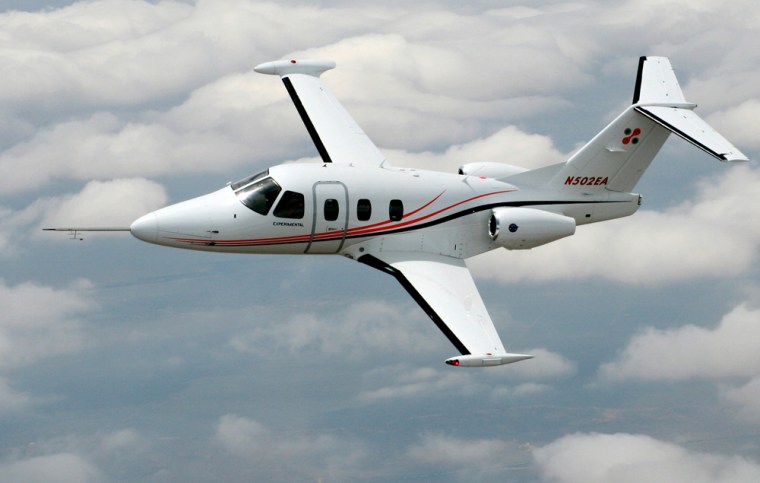Planning a plane trip? Depending on when and where you’re flying, you may want to consider hailing a taxi instead. An air taxi, that is. Thanks to a fleet of “microjets” set to hit the market, hopping a jet could someday be as easy as hailing a cab.
Air taxis, of course, have been around for years. Geared primarily toward business travelers, most use turbo-prop planes and smaller airports to provide on-demand service for regional travel. Now, though, forward-thinking flyers are hoping "very light jets" (VLJs) may make such services feasible for the rest of us.
The idea is to provide an alternative to the current air-traffic system, where “hurry up and wait” has become the grumbled mantra of millions of frazzled travelers. The pre-dawn drive to the airport to arrive 90 minutes before departure. The curbside congestion at the terminal. The snail-paced search for a parking spot. We converge at the ticket counter, shuffle through security and jam up the jetway, a harried herd with an increasingly bad attitude.
To paraphrase the old tag line from long-defunct National Airlines, “Is this any way to run an airline industry?”
Maybe not, thanks to the first of a fleet of VLJs (also known as "microjets") that may hit the runway over the next several months. Technically speaking, a microjet has a maximum takeoff weight of 10,000 pounds and can be operated by a single pilot. Outfitted with four to eight seats, these jets are designed to provide direct, on-demand service between destinations up to 1,300 miles apart. (Most trips are expected to be 500 miles or less.) Traveling at speeds of 400 mph and up, they’re essentially souped-up air taxis, which may explain why they’ve been likened to SUVs with wings.
Small planes, small airports
And like SUVs, they’re designed to go off the beaten path. Instead of competing for space at major hubs like Atlanta, O’Hare, and DFW, VLJs can use many of the more than 5,000 local and regional airports across the U.S. Often close to both home and destination, they’re the kind of airports where the parking is free, the security’s easy, and the rental cars are right outside the door.

The combination -- small, fast planes using small, local airports -- has a blue-sky appeal that’s hard to resist: head to Disney World for the day from points all over the Southeast; visit Martha’s Vineyard from much of New England without ferries or connecting flights. Suddenly, those distant weddings and family reunions that you used to drive to could be doable without the backseat soundtrack of "Are we there yet? Are we there yet?"
Well, no actually, we’re not. While the idea of microjets for the masses is intriguing, the concept is not quite cleared for takeoff. Issues from pilot training to air-traffic control would need to be worked out, and a host of regulatory issues are as yet unresolved. (In mid-July, Eclipse Aviation, an industry frontrunner, was still waiting for FAA certification for its Eclipse 500.)
Then there’s the question of demand. With ticket prices expected to be higher than traditional coach fares, many members of the flying public may find the headaches of hub-based air travel a relative bargain. In the short term, most microjet seats will be filled by business travelers rather than vacationers.
Still, there’s plenty of excitement about VLJs. Three leading manufacturers (Eclipse, Cessna, and Adam Aircraft) currently have orders for approximately 3,000 planes, and several small airlines are gearing up to provide new (or improved) service. Here are a few of the concepts currently in development:
- Dayjet (http://www.dayjet.com/): Based in Delray Beach, Fla., Dayjet hopes to launch its per-seat, on-demand service by the end of 2006 (pending the necessary government approvals). In June 2006, the company announced that it would initially offer service among five smaller Florida airports: Boca Raton, Gainesville, Lakeland, Pensacola, and Tallahassee.
- Linear Air (http://www.linearair.com/): Currently using turbo-prop planes, Linear offers both on-demand and regularly scheduled service in the Northeast U.S. Their charter service operates like a ground-based taxi, with passengers paying by the trip, not by the individual seat, making it a more reasonable option for group travel. The company expects to jump into the microjet market once the jets become commercially available.
- Pogo Air (http://www.pogoair.com/): This Connecticut-based company dipped a wing in the VLJ game in 2004 when it placed a large order with Adam Aircraft, manufacturer of the eight-seat A700. They hope to start service in the Northeast sometime in 2009. While that’s late compared to their potential competitors, they may have one ace in the hole: Unlike the VLJs from Cessna and Eclipse, the A700 has a bathroom on board.
